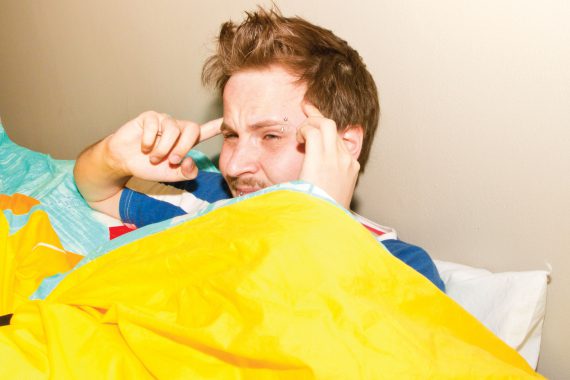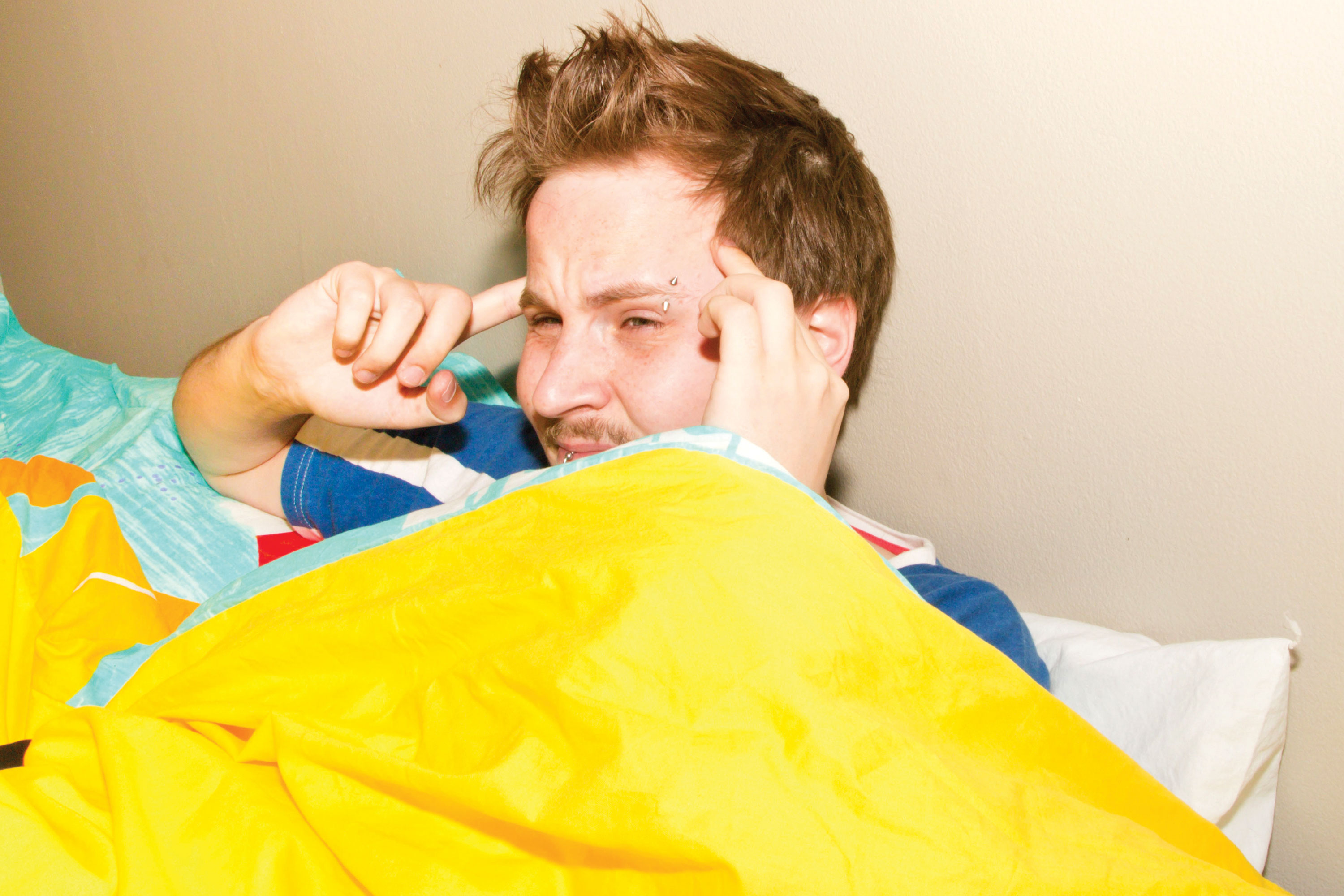Obscure diagnosis: exploding head syndrome


man with headache 3×2
Case history
A 20-year-old medical student was lying half-awake in bed in the morning, when he suddenly perceived a terrific bang in his head, which woke him fully and terrified him. He remained immobile for several minutes, petrified that he had suffered a subarachnoid haemorrhage, and that if he moved it could be fatal. After a few more minutes, however, it dawned on him that he had no other symptoms such as headache, nausea, vomiting, or indeed sudden death. Apart from feeling panicky, he was quite well. He gingerly got up, and the day carried on as normal, and by evening he wondered if he had imagined or dreamed it, and told no one. Several years later, while studying for exams, he came across EHS and realised that was the diagnosis.
Exploding head syndrome (EHS) is the dramatic term used to describe a specific set of symptoms that are alarming for both patients and their doctors, but entirely benign with an excellent prognosis.
Despite being initially described over 120 years ago,1,2 there has been little research into EHS, probably due to its benign nature. Accurate knowledge on prevalence and pathophysiology remains elusive and treatment options are anecdotal. Diagnosis relies on an accurate history.3
Recognition is important as the diagnosis will protect patients from unnecessary investigations and treatment. Patient education and reassurance has been shown to be therapeutic and in some circumstances, curative.4,5
Definition
Although the condition was initially described in 1890 and again in 1920, Pearce reported the first case series in 1988 and assigned the label EHS.6 Since then, several case reports have emerged and what is remarkable is the consistency in the description given by patients.7 This has allowed the condition to become a well-defined entity and is formally classified as a ‘sensory parasomnia’ in the International Classification of Sleep Disorders. The diagnostic criteria are detailed in table 1 on page 56.7,8
Prevalence
The prevalence is unknown, as the literature consists of case reports and there have been no detailed epidemiological studies.3 Some have described EHS as rare but others suggest it is common and under-recognised.4,6 Following the publication of the initial 10-patient case series in 1988, there was a marked increase in reported cases, allowing a 50-patient case series to be collated by the same author in 1989, which remains the largest to date.4,6 Point prevalence for EHS may be as high as 10% in otherwise healthy people.3
EHS has been described across a broad range of ages, but is generally considered to be a condition of the middle-aged and elderly, with a median age at onset of 54 years.
There is a female predominance of approximately 1.5:1.7
Clinical features
The syndrome is predominantly characterised by auditory perceptions of a loud, alarming noise when falling asleep, wakening or during a period of restful relaxation.4 The noise is typically of sudden onset, brief and painless. But the explosive onset results in significant distress and fear, which can subsequently result in the misperception that the symptoms are painful: ‘an enormous roar, so loud it could kill me’.4
Understandably, patients are concerned that there is a sinister underlying cause such as a brain tumour or intracerebral haemorrhage,4 but it has been recognised that despite their anxiety, patients rarely volunteer these episodes as a presenting symptom and it has been postulated that this is due to a fear of not being believed.4
Descriptions of the noise include a ‘bomb explosion’, ‘terrific bang’, ‘door slamming’, ‘loud clap’, ‘electrical current running’ and ‘enormous roar’.3,7,9 Attacks are typically painless and invariably lead to considerable fear. Their distressing nature frequently results in patients inaccurately describing their symptoms as painful, although a careful history should confirm that this is indeed not the case. Mild pain has been reported in some case studies.5
In addition to auditory perceptions, several other symptoms have become well recognised, although are not required to make the diagnosis. The most common is visual disturbance, which often takes the form of flashing lights or ‘visual static’.4 Other associations include anxiousness, tachycardia, sweating, mild jab-like pain and rarely, myoclonic jerks.4,10 In the largest case series, some reported the sensation of having stopped breathing and having to make a conscious effort to breathe with an ‘uncomfortable gasp’.4 Other reports have suggested an association with sleep paralysis, obstructive sleep apnoea and migraine.11,12,13
The symptoms can occur in relaxed wakefulness, but are well recognised during the transition states of sleep (from wake to sleep or sleep to wake). The pattern and frequency of attacks is variable. They may occur once in a lifetime or they may be episodic with variable frequency. Some patients develop a chronic form of the condition and suffer several attacks a night, which can subsequently lead to insomnia or apprehension about falling asleep. Episodes may be followed by long periods of remission.4,14
Although the aetiology of EHS remains unknown, stress and ‘emotional tension’ have been described as risk factors.1,4 Others have suggested links to benzodiazepine and SSRI withdrawal.3
Neurological examination is normal and investigation unnecessary. The diagnosis is dependent on an accurate history and recognition of the condition. Given the association between sleep and rest, some patients have been investigated with polysomnography, with normal results.14
Differential diagnosis
Given that EHS is infrequently considered and is an under-reported phenomenon, there is considerable potential for misdiagnosis.3 In truth, there is no differential diagnosis, as the history is so utterly characteristic. Common misdiagnoses include a primary (for example, migraine) or secondary (for example, subarachnoid haemorrhage) headache, nightmare disorder and epilepsy.
The history should differentiate EHS from these disorders and particular attention should be paid to the duration of their symptoms, when they occur and the presence of focal signs on examination.3 For example, true headache may waken patients from sleep – this includes cluster headache and migraine, as well as rarer syndromes such as hypnic headache or paroxysmal hemicrania. Distinguishing these primary headache disorders from EHS is usually straightforward based on the history, as the pain is often severe and the duration longer than the split-second of symptoms in EHS. Sleep onset frontal lobe focal seizures occur during non-REM sleep rather than in transition phases. Although they can present with explosive symptoms, patients are often amnesic of these symptoms, which would be unusual in EHS where a vivid account is frequently reported.5 A convulsive seizure is unlikely to be mistaken for EHS.
Pathophysiology
The pathophysiology of EHS is unknown,7 but there are a number of proposed theories. Some have suggested that it is related to ear dysfunction.1,5,6 Others have discussed a relationship with temporal lobe seizures, although this would seem unlikely given that electroencephalograms are normal during attacks in these patients.6 One group described EHS as part of a primary headache disorder and suggested it could be due to transient calcium dysfunction, as seen in hemiplegic migraine.9 But the most plausible and widely accepted theory is that EHS is a consequence of brainstem neuronal dysfunction during the transition from wakefulness to sleep. As we fall asleep, the neuronal activity in the brainstem reticular formation reduces. This subsequently ‘switches off’ the visual, sensory, motor and auditory parts of the cerebral hemispheres. It has been suggested that EHS is due to a delay in this switching off process.10,15,16
How can GPs diagnose EHS with certainty?
EHS is readily recognisable from the history. The keys are therefore:
• Obtaining this history.
• Recognising that EHS exists.
The diagnostic clues from the history are the brevity and the nature of the symptoms, without anything more persistent, and specifically the lack of pain. If in doubt, a call to a neurologist should help clarify matters. Non-neurologists are less likely to be aware of EHS, and might recommend tests.
Treatment
Most patients respond well to a careful explanation and reassurance and do not require medication.1,5,6 To date, there have been no controlled trials regarding the management of recurrent EHS.7 There has been anecdotal evidence from several case studies supporting the use of clomipramine,14 nifedipine,11 flunarizine10,14 and topiramate.17
In the instances where there is a co-existent sleep disorder, such as obstructive sleep apnoea, there have been reports of EHS resolving after the treatment of this.13
When to refer
Early referral to hospital should be considered if pain is a prominent feature, particularly if the onset was sudden, persistent and in the presence of signs. Indeed, any features that raise concern about an underlying cause would warrant referral to neurology. Given its apparent rarity, or at least presentation to doctors, GPs may reasonably feel more confident after discussion with a neurologist.
Dr Louise Davidson is a neurology specialist trainee, and Dr Richard Davenport a consultant neurologist, both based at Western General Hospital, Edinburgh
Key points
• EHS is a loud, alarming noise which is brief and of sudden onset
• It is painless but causes significant concern
• It usually happens when falling asleep or waking
Diagnostic criteria for EHS
• There is a complaint of a sudden loud noise or sense of explosion in the head either at the wake-sleep transition or upon waking during the night
• The individual experiences abrupt arousal following the event, often with a sense of fright
• The experience is not associated with significant complaints of pain
References
1 Mitchell SW. Some disorders of sleep. Int J Med Sci 1890;100:109-27
2 Armstrong-Jones R. Snapping of the Brain. Lancet 1920;ii:720
3 Sharpless BA. Exploding Head Syndrome. Sleep Medicine Reviews 2014;18:489-93
4 Pearce JMS. Clinical features of the exploding head syndrome. J Neurol Neurosurg Psychiatry 1989;52:907-10
5 Ganguly G, Mridha B, Khan A et al. Case Rep Neurol 2013;5:14-17
6 Pearce JMS. Exploding Head Syndrome. The Lancet 1988;ii:270-1
7 Frese A, Summ O, Evers S. Exploding Head Syndrome: Six new cases and review of the literature. Cephalalgia 2014;34:823-7
8 American Sleep Association. Diagnostic Classification Sleeping Committee. International Classification of Sleep Disorders: diagnostic and coding manual. Westchester: American Academy of Sleep Medicine 2005.
9 Jacome DE. Exploding Head Syndrome and idiopathic stabbing headache relieved by nifedipine. Cephalalgia 2001;21:617-8
10 Chakravarty A. Exploding Head Syndrome: report of two new cases. Cephalalgia 2007;28:399-400
11 Evans RW. Exploding head syndrome followed by sleep paralysis: a rare migraine aura. Headache 2006;46: 682-91
12 Kallweit U, Khatami R, Bassetti CL. Exploding head syndrome – more than ‘snapping of the brain’? Sleep Medicine 2008;9:589
13 Okura M, Taniguchi M, Muraki H et al. Case of exploding head syndrome. Brain Nerve 2010;62:85-8.
14 Sachs C, Svanborg E. The exploding head syndrome: polysomnographic recordings and therapeutic suggestions. Sleep 1991;14:263-6
15 Evans RW, Pearce JMS. Exploding head syndrome. Headache 2001;41:602-3
16 Queiroz LP. Unusual Headache Syndromes. Headache 2013;53:12-22
17 Palikh GM, Vaughn BV. Topiramate responsive exploding head syndrome. Journal of clinical sleep medicine 2010;6:382-3
Pulse July survey
Take our July 2025 survey to potentially win £1.000 worth of tokens

Visit Pulse Reference for details on 140 symptoms, including easily searchable symptoms and categories, offering you a free platform to check symptoms and receive potential diagnoses during consultations.










